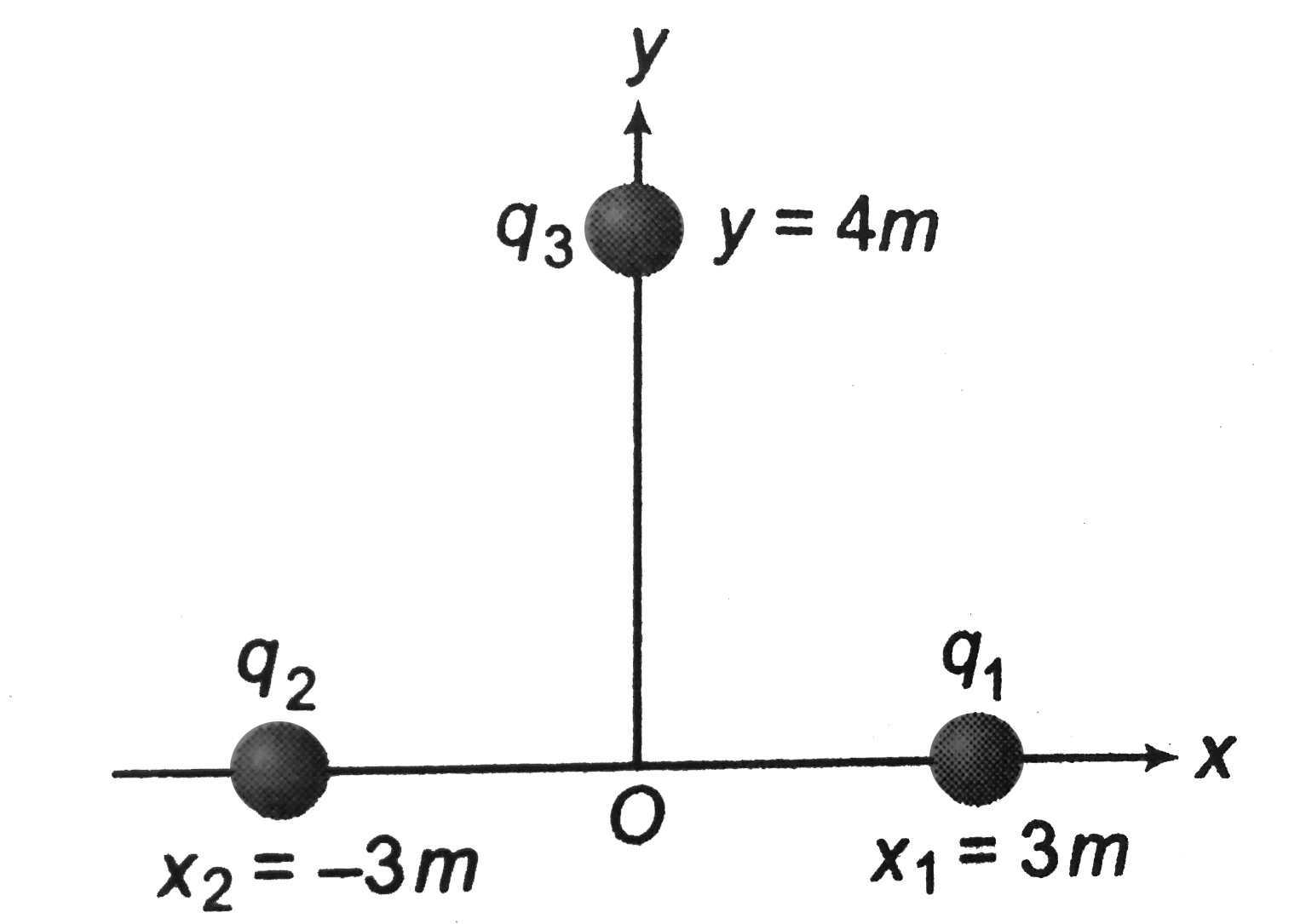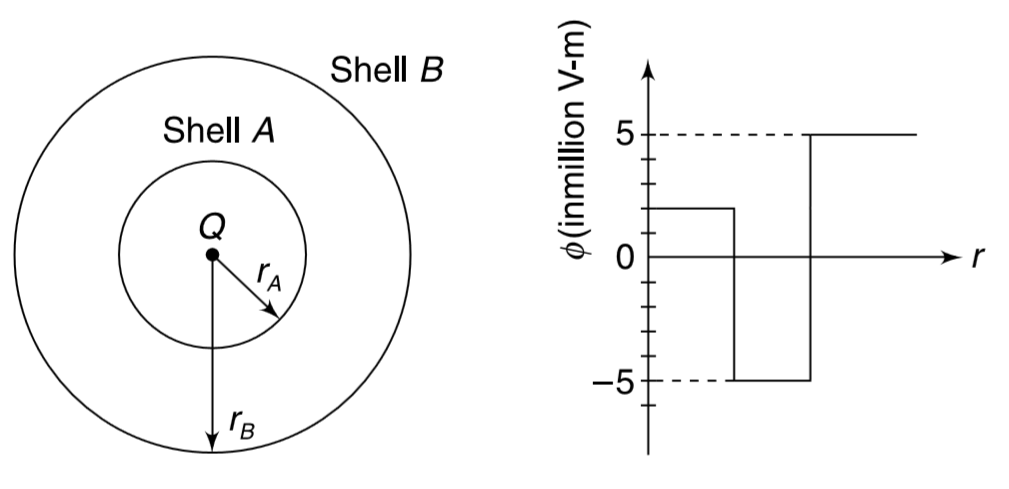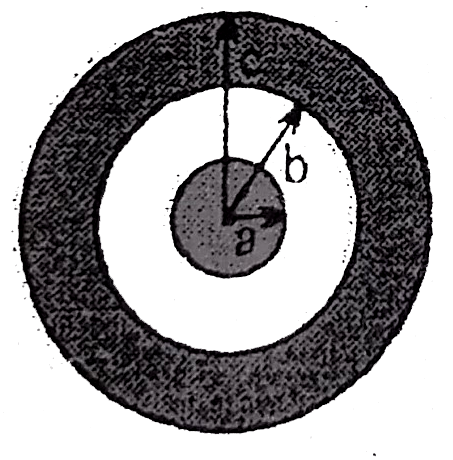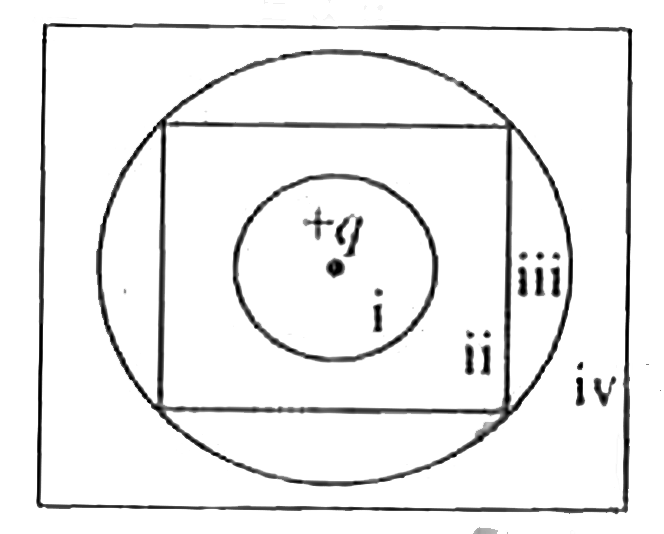A charged particle is suspended at the center of two thin concentric spherical charged shells, made of nonconducting material. Figure shows cross section of the arrangement. Figure (b) gives the net flux through a Gaussian sphere centered on the particle, as a function of the radius r of the sphere.
 ,
,
What is the charge on the central particle?
The correct Answer is:B
We see that remains constant up to . So . Let q be the charge at centre than
or or ltBrgt Similarly
Where is the charge on A. electric field is zero nowhere as is not zero anywhere.

Topper's Solved these Questions
- BOOK - CENGAGE PHYSICSCHAPTER - MISCELLANEOUS VOLUME 3EXERCISE - Interger Answer type20videos
MISCELLANEOUS VOLUME 3
- BOOK - CENGAGE PHYSICSCHAPTER - MISCELLANEOUS VOLUME 3EXERCISE - Fill in the blanks10videos
MISCELLANEOUS VOLUME 3
- BOOK - CENGAGE PHYSICSCHAPTER - MISCELLANEOUS VOLUME 3EXERCISE - Assertion and Reason Type8videos
MISCELLANEOUS VOLUME 3
- BOOK - CENGAGE PHYSICSCHAPTER - MECHANICAL PROPERTIES OF SOLIDSEXERCISE - Question Bank4videos
MECHANICAL PROPERTIES OF SOLIDS
- BOOK - CENGAGE PHYSICSCHAPTER - MISCELLANEOUS VOLUME 5EXERCISE - Integer12videos
MISCELLANEOUS VOLUME 5
Similar Questions
Two point charges q1=q2=2μC are fixed at x1=+3m and x2=−3m as shown in figure. A third particle of mass 1 g and charge q3=−4μC are released from rest at y=4.0m.Find the speed of the particle as it reaches the origin.
 05:50View Solution
05:50View SolutionFive identical capacitor paltes, each of area A, are arranged such that adjacent plates are at a distance d apart, the plates are connected to a source of emf V as shown in the figure

The charge on plate 1 is ………..and on plate 4 is.............View SolutionStatement I: When air between the plates of a parallel plate condenser is replaced by an insulating dielectric medium, its capacity decreases.
Statement II: Electric field intensity between the plates with dielectric in between is reduced.02:51View SolutionThe diameter of a brass rod is 4 mm and Young's modulus of brass is 9×1010N/m2. The force required to stretch by 0.1 % of its length is
View SolutionA charged particle enters a uniform magnetic field with velocity v0=4m/s perpendicular to it, the length of magnetic field is x=(√32)R, where R is the radius of the circular path of the particle in the field. Find the magnitude of charge in velocity (in m/s) of the particle when it comes out of the field.
03:50View SolutionA charged particle is suspended at the centre of two thin concentric spherical charged shells, made of non conducting material. Figure A shows cross section of the arrangement. Figure B gives the net flux ϕ through a Gaussian sphere centered on the particle, as a function of the radius r of the sphere.

What is the charge on shell A ?00:53View SolutionA charged particle is suspended at the center of two thin concentric spherical charged shells, made of nonconducting material. Figure shows cross section of the arrangement. Figure (b) gives the net flux phi through a Gaussian sphere centered on the particle, as a function of the radius r of the sphere. , In which range of the values of r is the electric field zero?
View SolutionAn infinite, uniformly charged sheet with surface charge density sigma cuts through a spherical Gaussian surfance of radius R at a distance X from its center, as shown in the figure. The electric flux Phi through the Gaussian surfce is .
03:41View Solution
A charged particle is placed at the centre of two thin concentric spherical charged shells, made of non-conducting material. Figure A shows cross-section of the arrangement. Figure B gives the net flux ϕ through a Gaussian sphere centered on the particle, as a function of the radius r of the sphere. (a) Find charge on the central particle and shell A. (b) In which range of the finite values of r, is the electric field zero?05:50View SolutionA nonconducting sphere with radius a is concentric with and surrounded by a conducting spherical shell with inner radius b and outer radius c. The inner sphere has a negative charge uniformly distributed throughout its volume, while the spherical shell has no net charge. The potential V (r) as a function of distance from the center is given by
 05:15View Solution
05:15View Solutionfigure shows, in cross section, two Gaussian spheres and two Gaussian cubes that are centered on a positively charged particle on a positively charged particle . Rank greatest first, and indicate whether the magnitudes are uniform or variable along each surface.
 View Solution
View SolutionGraph shows magnitude of electric field (E) , charge enclosed (q_("enclosed:)) within the concentic sphere and net flux (phi) through a concentric spherical Gaussian surface as a function of distance (r) from centre of a uniformly positive charged solid sphere of radius R. Choose the correct option (s):
05:00View SolutionA charged particle is suspended at the centre of two thin concentric spherical charged shells, made of non conducting material. Figure A shows cross section of the arrangement. Figure B gives the net flux phi through a Gaussian sphere centered on the particle, as a function of the radius r of the sphere. What is the charge on the central particle ?
03:47View SolutionA charged particle is suspended at the centre of two thin concentric spherical charged shells, made of non conducting material. Figure A shows cross section of the arrangement. Figure B gives the net flux ϕ through a Gaussian sphere centered on the particle, as a function of the radius r of the sphere.

What is the charge on shell A ?02:52View SolutionA charged particle is suspended at the centre of two thin concentric spherical charged shells, made of non conducting material. Figure A shows cross section of the arrangement. Figure B gives the net flux ϕ through a Gaussian sphere centered on the particle, as a function of the radius r of the sphere.

In which range of the values of r is the electric field zero ?03:05View Solution

